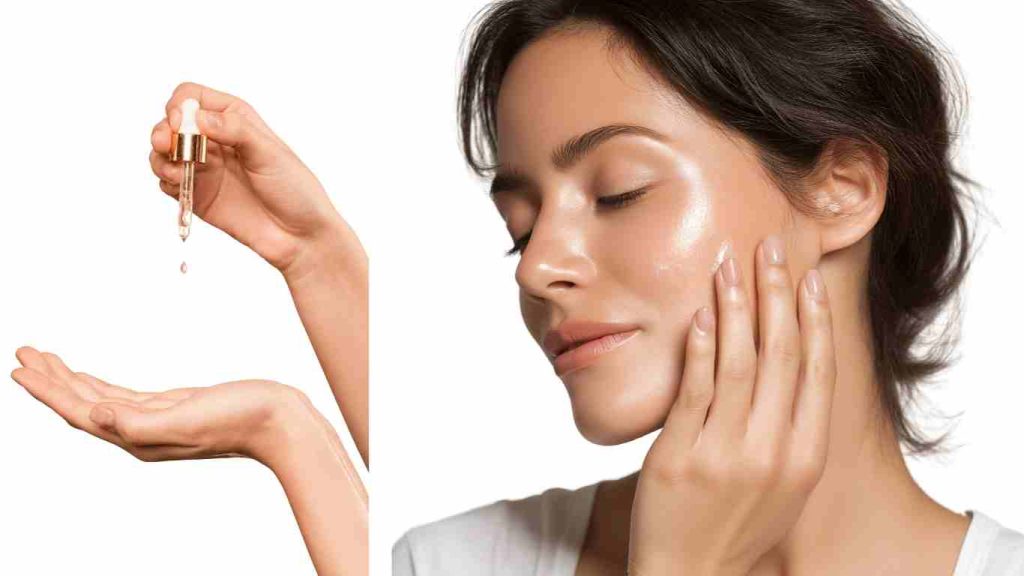Looking for the best exosome serum for anti-aging at home? You’re in the right place! In the ever-evolving world of skincare, exosome serums are the latest superstar ingredient promising youthful, glowing skin. This complete guide covers everything: what exosomes are, benefits for aging skin, before-and-after results, how to use exosome serums at home, top affordable picks, differences versus stem cell serums, dermatologist opinions, safety, and even a step-by-step anti-aging routine with exosomes. Get ready to learn insider tips and the science behind these “liquid gold” serums and achieve radiant, glowing skin from the comfort of home.
What Are Exosomes and How Do They Work?
![Woman with glowing skin holding anti-aging exosome serum bottle]
Exosomes are nano-sized vesicles (30–200 nm) that cells use to communicate and regenerate. Think of them as tiny “postcards” sent by cells containing proteins, lipids, and growth factors. When applied topically in serums, exosomes deliver powerful signals to your skin cells, triggering collagen and elastin production, boosting repair, and reducing inflammation. According to Vogue, studies show exosomes can “trigger the production of new blood vessels, reduce inflammation, and [support] collagen synthesis,” helping to diminish fine lines, pigmentation, and plump up the skin. In short, exosomes give your skin the blueprint for repair – they support natural skin renewal, calm redness, and promote firmer, more youthful skin.
Benefits of Exosome Serum for Aging Skin
![Bottle of amber-colored exosome serum on mirror]
Exosome serums target multiple signs of aging at the cellular level. They deliver growth factors and proteins that stimulate fibroblasts, improving elasticity and reducing fine lines. Key benefits include:
- Boosted Collagen & Elasticity: Exosomes can dramatically increase collagen production, making skin firmer and plumper. Some treatments report collagen levels rising up to 700%. This firms up sagging skin and smooths wrinkles.
- Reduced Wrinkles and Fine Lines: By supporting collagen and elastin, exosome serums help diminish fine lines and wrinkles. Dermatologists note they “soften fine lines and wrinkles” as part of overall skin rejuvenation.
- Improved Texture & Pores: Ingredients like exosome-coated micro-needles can push active ingredients deeper, accelerating cell turnover for smoother, more even skin and smaller pores.
- Even Tone & Brightening: Exosomes help fade dark spots and sun damage by reducing pigmentation. They work like a gentle “reset” for dull or spotty skin.
- Intense Hydration & Barrier Repair: By enhancing the skin’s barrier function, exosome serums lock in moisture for plump, glowing skin. Many serums include hyaluronic acid and peptides for extra hydration.
- Reduced Inflammation & Redness: Exosomes carry anti-inflammatory factors. They calm irritation and redness, making them ideal for sensitive, acne-prone, or post-procedure skin. (One influencer reported markedly reduced redness within a week of using an exosome serum daily.)
- Faster Healing & Cell Turnover: Topical exosomes can speed up healing after treatments. In clinical tests, exosome-treated skin showed an 11.3% boost in elastin vs. untreated skin, meaning faster recovery and bouncier skin.
In short, exosome serums deliver a regenerative, anti-aging boost: they collaborate with your skin’s biology to firm, brighten, and smooth your complexion, often with no irritation that more aggressive treatments (like retinols) can cause.
Anti-Aging Skincare for Women Over 40: Tips for Timeless Beauty
How to Use Exosome Serum at Home
![Dropper applying anti-aging exosome serum]
To get the most from your exosome serum, follow a consistent skincare routine. Apply it after cleansing so your skin is clean and pores are open. If you use actives (like vitamin C or retinol), here’s a simple order:
- Cleanse: Start with a gentle cleanser to remove makeup and debris.
- Apply Actives (Optional): If using treatments like vitamin C or retinoid/retinol, apply those first. Many dermatologists advise using exosome serum “at night, after retinoid, and before moisturizing”, because the skin regenerates best overnight.
- Exosome Serum: Dispense a few drops of the serum (use the dropper carefully) and gently massage into your face and neck. Exosomes work at a cellular level, so patting them in with clean fingertips helps absorption.
- Moisturize: Follow with a moisturizer to seal in hydration. Because exosome serums often repair the skin barrier, teaming them with a quality moisturizer maximizes plumpness and smoothness.
- Sunscreen (AM Only): In the morning, always finish with a broad-spectrum SPF. This protects your new skin from UV damage and helps preserve the serum’s results.
Most sources recommend using exosome serum daily – either once a day at night (for intensive repair) or morning and night for continuous benefit. Consistency is key. Remember, unlike some prescription therapies, these serums build results over time. One real-world user saw major improvements (reduced redness and softer skin) within about 10–30 days of nightly use. Stick with it, and you’ll likely see your skin looking smoother, firmer, and more radiant over weeks.
Exosome Serum Before and After Results
Many users report noticeable improvements after a few weeks of exosome serum use. In a celebrity editor’s real-life test, applying a clinical-strength exosome serum daily for 30 days dramatically reduced redness, inflammation, and uneven texture. Even areas with old sun damage and broken capillaries calmed down. By day 10, her skin felt “baby-soft” and fine lines looked less pronounced. Overall, she found exosomes “worked with her skin rather than against it” – leaving it calmer and visibly smoother.
Of course, results vary by product and individual. Some of the most impressive changes include: softer skin, smaller pores, fewer fine lines, and more even tone. Clinically, studies have shown that exosome serums can significantly boost markers of skin health (e.g. collagen and elastin production) within weeks. Before/after photos in marketing often highlight visible wrinkle reduction and glowing skin after just 4–8 weeks of consistent use. For best results, follow expert advice on application (after cleansing or retinoid, plus SPF) and be patient – the cellular renewal process takes time.
Affordable Exosome Serums for Beginners
Beauty doesn’t have to break the bank. Budget-friendly exosome serums are now available for beginners. For example, Vogue names Medicube One Day Exosome Shot 7500 and The Inkey List Exosome Hydro-Glow Complex as top picks at about $22 each. These formulas pair exosomes with other effective ingredients (like niacinamide, peptides, or hyaluronic acid) to promote collagen and hydration. The Medicube serum uses “liquid microneedles” to drive ingredients deeper, smoothing texture and minimizing pores. The Inkey List option combines cica-derived exosomes with peptides for firmer skin and hyaluronic acid for hydration.
Other reasonably priced serums include Skinfix’s Exo + Ectoin Retinol-Alternative ($69) and SickScience’s PowerCycle Serum ($58). These may not have the ultra-high exosome concentration of luxury brands, but they make great starter exosome serums that can noticeably boost skin health. On the higher end, clinical-grade products like [plated] Skin Science’s Intense Serum run $258, and luxury names like Barbara Sturm’s Exoso-Metic serum cost $535. The takeaway: you can get real anti-aging benefits without spending hundreds. For beginners, the under-$30 exosome serums (Medicube, Inkey List) are smart entry points to test the waters.
Exosome Serum vs Stem Cell Serum
Exosome serums are often compared to stem cell–based products, but they’re not the same. Stem cell serums contain live cells (or cells’ growth factors) harvested from donors, which aim to regenerate tissue. Exosome serums, by contrast, contain only the signaling vesicles (exosomes) released from those cells. In practice, that means exosomes deliver the regenerative messages without introducing whole cells. Experts explain that because exosomes are cell-free, they carry a much lower risk of immune rejection or tumor formation.
In fact, exosomes are often touted as a safer, more stable alternative. They prompt your existing skin cells to repair and produce collagen, rather than relying on new cells to engraft. A medical spa article notes: “Exosomes do not become new tissue themselves; instead, they prompt your existing cells to repair and regenerate”. This means you often see faster, more consistent results with less downtime. Meanwhile, stem cell therapy can take longer to integrate and carries more complexity. In our anti-aging context, think of it this way: an exosome serum is like a delivery of potent instructions to your skin, whereas a stem cell serum delivers the raw materials.
Our sources agree: for most at-home skincare goals, exosome serums are usually preferable. They tend to be more stable, easier to standardize, and have fewer side effects. For example, one review says exosomes “offer a range of skincare advantages” similar to stem cells, but without the complications of live cells. So if you want the anti-aging magic of cellular regeneration without the risks, exosome serums are often the safer bet.
Anti-Aging Skincare Routine with Exosome Serum
Building an anti-aging routine around exosome serum can amplify its benefits. Here’s a simple example daily routine for glowing skin:
- Morning: Cleanse → Exosome Serum → Moisturizer → SPF. Using your exosome serum in the morning (post-cleanse) gives your skin a healing boost right after overnight repair. The hydrating, repair-focused serum pairs well with a daily moisturizer and of course sunscreen.
- Evening: Cleanse → (Retinol/acid if you use one) → Exosome Serum → Night Cream. Many dermatologists recommend applying exosome serum “at night, after retinoid, and before moisturizing”. Nighttime is when the skin is most receptive to repair, so layering the serum after a retinol or peptide treatment (if used) maximizes collagen-building while you sleep.
Weekly or after-procedure extras: After treatments like microneedling or laser resurfacing, applying a topical exosome serum can accelerate healing and minimize downtime. As Dr. Park (Vogue) notes, professionals often apply concentrated exosome serums post-needling to enhance absorption and reduce recovery time.
Overall, exosome serums complement other anti-aging steps. They can be layered with ingredients like vitamin C, peptides, or hyaluronic acid for a powerhouse regimen. According to The Inkey List, exosomes support cellular regeneration with minimal irritation, making them a great addition alongside retinol or vitamin C. Just remember: always finish your routine with sunscreen in the AM and never mix too many actives at once. The smart use of exosome serum is to boost the natural repair cycle that your other products help initiate.
Dermatologist Opinions on Exosome Serum
Board-certified dermatologists and plastic surgeons are watching the exosome trend closely. Most agree that exosomes have real regenerative promise, but they emphasize safety and sourcing. For example, Dr. Jennifer Levine (facial plastic surgeon) describes exosomes as tiny pouches carrying cell-communication signals – “basically a cell’s text message” to promote skin repair. Dr. Gershonni Gohara (dermatologist) and others note that exosomes can “drastically reduce healing times, reduce fine lines and wrinkles, hydrate the skin, and promote collagen and elastin”. Another expert adds that exosomes are great for supporting normal cell functions, so you often see faster improvement with minimal discomfort or irritation.
However, dermatologists stress caution. They recommend only using exosomes under reputable conditions. Dr. Wyles and others advise looking for FDA-approved, human-derived sources and to avoid injections outside medical settings. In fact, New York Magazine recalls an FDA warning against unverified stem cell/exosome products, noting that cosmetic uses aren’t regulated like drugs. The consensus: always consult a medical professional for advice and use exosome serums as directed.
Some dermatologists specifically recommend board-certified aesthetic providers when trying exosome treatments. As one expert puts it, ensure your exosome serum comes in sterile single-use vials and is administered by a qualified professional if in-office. For at-home serums, look for clear sourcing. (For instance, Vogue notes most clinic-grade exosomes come from human stem cells, whereas OTC versions might use human- or plant-derived exosomes.)
In summary, many doctors are optimistic about exosomes in skincare but advise doing your homework: follow proper usage, don’t inject anything without medical supervision, and treat OTC serums as a supplement, not a miracle cure. If you have underlying skin conditions or concerns, a dermatologist’s guidance can ensure you use exosome products safely and effectively.
Exosome Serum Side Effects and Safety
Exosome serums are generally well-tolerated because they don’t contain live cells. That means fewer side effects than some alternatives. In practice, most users experience minimal irritation. The main reported side effect is temporary skin irritation or redness, especially when starting or if the formula is very potent. A patch test is always wise with any new serum.
Safety concerns mainly revolve around sourcing and stability. Because exosomes carry genetic and protein material, experts warn about unknown risks of transferring DNA or infections. While no serious problems have been reported from topical serums yet, Dr. Melanie Palm cautions that quality matters: you don’t want someone else’s genes or pathogens inadvertently applied to your face. Therefore, buy exosome serums from reputable brands that clearly explain their sourcing. As one guide advises, steer clear of companies that skip FDA testing or aren’t transparent about their exosome origin.
Another important safety tip: exosomes require special handling. They are unstable and need proper preservation. OTC products must be shelf-stable, so some skeptics wonder if the exosomes in them remain active. Look for storage instructions (some recommend refrigeration) and strict purification processes. As Visodent NYC notes, exosome serums are most effective when fresh and properly stored.
Finally, exosomes should only be used topically. Don’t inject them at home! Dermatologists warn that only trained professionals should handle injections, and even then, only in approved contexts. In short, side effects are rare for quality topical exosome serums. To stay safe: consult a dermatologist, do a patch test, avoid injections outside a clinic, and choose products with good reviews and transparency.
Best Time to Apply Exosome Serum at Home
The optimal timing for exosome serum can amplify its benefits. Nighttime use is especially popular: your skin undergoes repair and regeneration while you sleep, so applying the serum before bed (after any retinoids) maximizes its action. Dr. Gohara specifically recommends using exosomes “at night, after retinoid, and before moisturizing” to align with the skin’s natural recovery cycle.
That said, using exosome serum in the morning also has perks. After cleansing in the AM, the serum can protect and prep your skin for the day. As the Inkey List notes, applying exosome serum immediately after cleansing (before moisturizer and SPF) is ideal. Morning use can boost hydration and repair during daily exposure.
In practice: many people apply their exosome serum twice daily. If you use other actives, apply retinol and acids first, then the serum, and follow with moisturizer/SPF. Whether AM or PM, consistency matters more than the exact hour. Some experts even suggest a short waiting period (e.g. 5–10 minutes) after applying the serum to let it sink in before layering other products.
Pro tip: If you only have time for one application, choose nighttime. Your skin is prime for regeneration then. But if you can do both AM and PM, that double dose of collagen-boosting goodness can’t hurt. Just keep in mind that exosomes are sensitive, so seal them in with a moisturizer and stay out of harsh sun without SPF.
Exosome Serum for Wrinkles and Fine Lines
Among all anti-aging targets, reducing wrinkles and fine lines is a top goal – and exosome serums shine here. By supercharging collagen and elastin production, these serums help plump and firm the skin from within. In the benefits section we already noted their smoothing effect on creases. For example, one doctor explains that exosome serums help “iron out fine lines, erasing sun damage and preventing sagging” by supporting the skin’s natural turnover.
In real-world use, many people report their lines becoming less noticeable after consistent use. An expert tester from The Daily Beast saw her pre-existing fine lines soften over 30 days, thanks to the serum’s gentle collagen boost. Clinical data backs this up: some studies show significant elastin gains in treated skin (11.3% more), which translates to bouncier skin with fewer wrinkles.
To target wrinkles effectively, focus exosome serum on areas of concern. Apply extra drops on forehead lines, crow’s feet, and smile lines as part of your regimen. Always pair the serum with moisturizing and sun protection – keeping skin hydrated and shielded from UV damage further helps line reduction. In short, think of exosome serum as a powerful wrinkle filler from the inside out: it doesn’t just mask lines but encourages your skin to renew itself, making wrinkles softer and less deep over time.
Frequently Asked Questions
Q1: What exactly is an exosome serum?
A: An exosome serum is a skincare product infused with exosomes, the tiny vesicles cells use for communication. These carry growth factors, proteins, and other signals that tell your skin cells to repair, produce collagen, and regenerate. Unlike traditional serums, exosome serums actively support cellular renewal and have potent anti-inflammatory and anti-aging effects.
Q2: How do I use exosome serum in my routine?
A: Use it after cleansing (and after any treatments like vitamin C or retinoid). According to experts, apply exosome serum at night after a retinoid and before moisturizer. You can also use it in the morning after cleansing. Pat a few drops onto your face, let it absorb (5–10 min), then follow with moisturizer and SPF. Consistency (daily use) is key for best results.
Q3: What are the main benefits of exosome serum for aging skin?
A: Exosome serums boost collagen and elastin, which firms skin and softens wrinkles. They improve skin texture, hydration, and even out tone by promoting cell turnover. They also reduce inflammation and redness due to their anti-inflammatory factors. Overall, they rejuvenate skin at the cellular level, leading to a brighter, smoother, more youthful complexion.
Q4: Are exosome serums safe? Any side effects?
A: Yes, exosome serums are generally safe for most people. Since they’re cell-free, the risk of complications is very low. The most common side effect is mild irritation or redness in sensitive users. To be safe, choose products from reputable brands with clear sourcing and avoid any claims of home injections. If in doubt, do a patch test and consult a dermatologist before starting.
Q5: Exosome serum vs stem cell serum – which is better for anti-aging?
A: For skincare, exosome serums are often preferred. They use the active “messengers” without live cells, offering similar regenerative benefits with fewer risks. Exosomes stimulate your own cells to renew, whereas stem cell serums rely on donor cells. So exosomes give you that anti-aging boost (collagen, repair) in a gentler, more controllable way. In short, exosome serums are safer, and usually faster-acting alternatives.
Q6: How soon will I see results?
A: Results vary, but many people notice smoother, calmer skin within 1–4 weeks of regular use. More dramatic results (wrinkle reduction, brightening) typically appear after 4–8 weeks. Remember that exosomes work at the cellular level – consistent use over time yields the best, lasting improvements.
Q7: Can anyone use exosome serum?
A: Generally, yes. Exosome serums are suitable for most skin types, including sensitive and acne-prone skin. They are especially great if you’re looking for advanced anti-aging without harsh irritation. However, if you have a specific skin condition (like autoimmune disorders) or are on certain medications, ask a dermatologist first. As with any powerful active, start slow and patch-test if you’re concerned.
Q8: Are affordable exosome serums effective?
A: Definitely. Budget options like The Inkey List’s ($22) or Medicube’s ($22) formulas contain real exosomes and helpful extras (peptides, niacinamide, etc.). While they may have lower exosome concentrations than ultra-luxe serums, they can still improve texture and hydration. Many users happily see differences with these affordable serums, making them perfect for beginners.
Conclusion
Exosome serums are revolutionary in at-home anti-aging care – think of them as microscopic helpers that supercharge your skin’s own renewal process. By delivering growth factors directly to skin cells, the best exosome serum for anti-aging at home can firm, brighten, and smooth your complexion like never before. In this guide we’ve shown how to use them effectively, the science-backed benefits, and even affordable options to try.
Remember: apply the serum consistently after cleansing (and ideally at night for maximum repair), pair it with a good moisturizer and SPF, and be patient as your skin renews. If you choose quality products and follow the dermatologist tips above, you’ll be well on your way to glowing, youthful skin. Do you have thoughts or questions about exosome serums? Share your experience below or tell us what you’d like to try next! And if this guide helped you, please share it with friends on social media so everyone can get radiant, healthy-looking skin.








